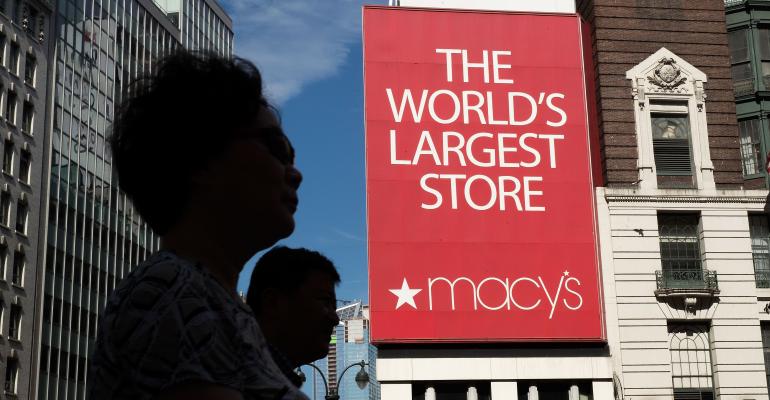(Bloomberg)—Adapt or die isn’t just a tenet of evolution: It’s also the reality faced by the U.S. department-store industry. And some are doing it far better than their rivals.
Although the chains are often lumped together with other mall mainstays when lamenting the “retail apocalypse,’’ this past week’s earnings reports underscore just how different department stores’ strategies are amid a wider brick-and-mortar slowdown.
Nordstrom Inc., for instance, posted same-store sales that were almost four times higher than expected after drawing in buyers for both its full-priced and discounted merchandise, powered by a massive anniversary sale. At the other end of the spectrum, CEO-less J.C. Penney Co. saw its stock plunge to historic lows as it put more items on clearance to get rid of excess inventory. And for Macy’s Inc., which beat virtually every estimate set by the market but still disappointed investors, it seems the jury’s still out.
“If you’re not doing well now, you’ll have a hard time when thing slow down,” said Ivan Feinseth, chief investment officer at Tigress Financial Partners. “Right now, we have a 50-year low level of unemployment, you have a consumer that’s flush, a stock market at record levels, a strong housing market and easy and low-cost credit. So you have the Goldilocks environment, or the perfect environment, for the consumer.”
Here are some areas where the three competing chains are winning or losing. Their take-home lessons will be worth watching for when Kohl’s Corp. -- larger than all three by market capitalization -- reports on Tuesday.
Experimentation Can Work Wonders
Nordstrom tends to think outside of the box, and that’s appealing to today’s shopper. The company now has an inventory-free store, and it opened a shop for men’s goods in Manhattan in April, where customers can purchase items online and pick them up at any time -- even if the store is closed. It also bought Trunk Club, an online styling service that delivers personalized boxes of clothes to members, plus two tech startups to help digital operations.
“To me, it’s all about taking calculated chances so the customer sees it and appreciates it and it ends up building loyalty for Nordstrom,” said Gabriella Santaniello, founder of retail consultancy firm A Line Partners.
Macy’s isn’t sitting still, either. It purchased cosmetic maker Bluemercury in 2015 and snapped up New York-based concept store Story this spring, which rotates out inventory every three months. Still, the cost to experiment is high, with the company spending about $100 million more in the first half of the year to fund growth, spooking investors.
As for J.C. Penney, experimentation has been lacking.
“J.C. Penney has had no innovation. They haven’t acquired anything that is really value-creating. They are a traditional retailer in a time when traditional retail is dying. They might as well be in the caveman days,” Feinseth said. “J.C. Penney is unfortunately becoming the dinosaur of retail. They haven’t been able to adapt.”
Customers Want Multiple Channels
Macy’s has done “an incredible job” with omni-channel fulfillment, Feinseth said. “If they don’t have the item, they can ship it to you.” Plus, they do ongoing promotions and have perks for members of its loyalty program.
Nordstrom is also branching out online, with its digital sales up 23 percent in the latest quarter. In addition to the men’s store it opened in midtown Manhattan, it will be opening a women’s store across the street next fall.
J.C. Penney offers online shopping, but sales slowed in the second quarter as the company tries to fix its dotcom experience. Executives said that was intentional, and that the planned pullback will give it time to improve the site.
“Through this process we’ve learned a lot about what our customer really wants to buy digitally online,’’ chief digital officer Therace Risch said on the latest earnings call. “The changes that we’re making right now are going to enable us to grow this channel very sustainably over the long term.’’
A Unique Experience
Although department stores tend to fill the same anchor tenant spots in shopping malls, the experience in one store shouldn’t feel interchangeable with another.
In this area, Nordstrom stands out because of its pop-up shops and events, Santaniello said. The option to buy merchandise online and pick it up in the store or curbside (or at any time at all at the inventory-free locations) also enhances the experience, she said.
Nordstrom is also “succeeding in the niche of luxury apparel,” said Bob Phibbs, CEO of the Retail Doctor. “Unless you care enough to succeed in a niche, you will struggle as a retailer in 2018 like J.C. Penney and other brands.”
Macy’s, meanwhile, has a unique shopping experience by offering more value-priced items, Feinseth said, referring to non-brand name products offered at a discount. But the company is still refining its approach, according to Santaniello.
“I believe that Macy’s can take a page out of Nordstrom’s playbook by better localizing its product and in-store events, but also playing up customer service to gain loyalty,” she said.
J.C. Penney has struggled in this area. The company doesn’t offer as unique an experience and hasn’t been able to fend off competition, Feinseth said. J.C. Penney declined to comment on its turnaround plan.
“Honestly, I am at a loss for J.C. Penney. They need to stabilize their business before they do anything,” Santaniello said. “I am not sure how they can execute a turnaround at this point.”
--With assistance from Janine Wolf.To contact the reporter on this story: Hema Parmar in New York at [email protected] To contact the editors responsible for this story: Anne Riley Moffat at [email protected] Jonathan Roeder
COPYRIGHT
© 2018 Bloomberg L.P

